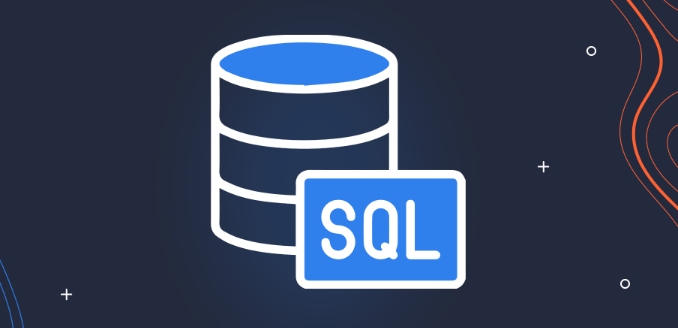Learning SQL from Scratch: A Systematic Approach for 2025
Aug 02, 2025 am 08:29 AMStart by understanding SQL as a language for querying relational databases, essential for data analysis and backend development in 2025. 2. Set up a beginner-friendly environment like SQLite with DB Browser or use free online platforms such as SQLFiddle, DB Fiddle, or Kaggle. 3. Follow a structured 5-week learning path: Week 1 focuses on basic queries using SELECT, FROM, WHERE, ORDER BY, and LIMIT; Week 2 covers aggregation with COUNT, SUM, AVG, and GROUP BY; Week 3 teaches JOINs to combine related tables; Week 4 introduces subqueries and CTEs for complex logic; Week 5 includes data modification with INSERT, UPDATE, DELETE, and schema basics like PRIMARY KEY and FOREIGN KEY. 4. Apply skills through real projects such as analyzing movie databases, tracking personal expenses, or querying public datasets from Kaggle or data.gov. 5. Adopt best practices early by writing clean, readable SQL with proper indentation, meaningful aliases, and comments. 6. Advance beyond basics with window functions, indexes, SQL integration in Python, and cloud tools like BigQuery or Snowflake, along with modern tools like dbt. Consistent daily practice, hands-on querying, using AI as a support tool, and engaging with communities like Reddit or Stack Overflow will accelerate learning, ensuring you can write efficient, real-world SQL by mid-2025.

Learning SQL from Scratch in 2025 doesn't have to be overwhelming. With the right structure, resources, and mindset, you can go from zero to writing efficient, real-world queries in just a few weeks. SQL (Structured Query Language) remains one of the most in-demand skills across data analysis, backend development, business intelligence, and data science. Here's a step-by-step, systematic approach tailored for 2025 learners.

1. Understand What SQL Is and Why It Matters
Before diving into syntax, know what you're learning and why.
- SQL is a domain-specific language used to communicate with relational databases.
- It’s used to retrieve, insert, update, delete, and analyze data.
- Major platforms like MySQL, PostgreSQL, SQL Server, SQLite, and cloud databases (BigQuery, Snowflake, Redshift) all use SQL—often with slight variations.
In 2025, data is more central than ever. Whether you're analyzing user behavior, generating reports, or building apps, SQL helps you get answers directly from data.

Tip: Think of SQL as asking precise questions to a database and getting structured answers.
2. Set Up a Learning Environment
You need a safe, free, and practical place to practice.

Recommended options for beginners:
-
SQLite with DB Browser (DB4S)
Lightweight, no setup needed. Great for learning basics. -
PostgreSQL with pgAdmin or Supabase
Industry standard, excellent for deeper learning. -
Online Platforms
Use free environments like:- SQLFiddle
- DB Fiddle
- Mode Analytics SQL Tutorial (includes real datasets)
- Kaggle SQL Course
Pro tip: Start with SQLite or an online sandbox. Avoid complex cloud setups at first.
3. Follow a Structured Learning Path
Break your learning into phases. Spend 1–2 weeks per phase, practicing daily.
Phase 1: Basic Queries (Week 1)
Master the foundation:
-
SELECT,FROM - Filtering with
WHERE - Sorting with
ORDER BY - Limiting results with
LIMIT - Using aliases (
AS)
Example:
SELECT name, age FROM users WHERE age > 25 ORDER BY age DESC LIMIT 10;
Practice: Retrieve data from a sample table like "employees" or "products".
Phase 2: Aggregation and Grouping (Week 2)
Learn to summarize data:
COUNT,SUM,AVG,MIN,MAXGROUP BYandHAVING- Filtering grouped data (vs.
WHERE)
Example:
SELECT department, AVG(salary) FROM employees GROUP BY department HAVING AVG(salary) > 50000;
Practice: Answer questions like “How many orders per customer?” or “What’s the average price per category?”
Phase 3: Joins and Relationships (Week 3)
Understand how tables relate:
INNER JOIN,LEFT JOIN- Using
ONto link tables - Self-joins (e.g., employees and managers)
Example:
SELECT u.name, o.order_date FROM users u LEFT JOIN orders o ON u.id = o.user_id;
Practice: Combine customer and order data. Use sample databases like SQLite’s “Chinook” or PostgreSQL’s “Pagila”.
Phase 4: Subqueries and CTEs (Week 4)
Write more complex logic:
- Subqueries in
SELECT,FROM, orWHERE - Common Table Expressions (
WITH) - Correlated subqueries
Example:
WITH high_value AS ( SELECT user_id FROM orders GROUP BY user_id HAVING SUM(amount) > 1000 ) SELECT name FROM users WHERE id IN (SELECT user_id FROM high_value);
Practice: Find users who spent more than the average, or rank products by sales.
Phase 5: Data Modification and Schema Basics (Week 5)
Go beyond reading data:
INSERT,UPDATE,DELETE- Understanding
PRIMARY KEY,FOREIGN KEY - Basic
CREATE TABLEand constraints
Example:
INSERT INTO users (name, email) VALUES ('Alice', 'alice@email.com');Note: Be cautious with
DELETEandUPDATE—always backup or use test databases.
4. Work on Real Projects
Theory isn’t enough. Build small projects to solidify skills.
Project ideas:
- Analyze a movie database (e.g., find top-rated directors)
- Track personal expenses with SQL
- Query public datasets (e.g., Google’s BigQuery public data)
- Replicate dashboard metrics (e.g., monthly signups, retention)
Use datasets from:
- Kaggle
- GitHub (search “sample SQL database”)
- U.S. government open data (data.gov)
5. Adopt Best Practices Early
Even as a beginner, write clean, readable SQL:
- Use consistent indentation
- Name aliases clearly
- Avoid
SELECT *unless exploring - Comment complex queries
- Break long queries into CTEs
Example of clean SQL:
-- Get active users who made purchases last month
WITH last_month_orders AS (
SELECT user_id
FROM orders
WHERE order_date >= '2025-03-01'
AND order_date < '2025-04-01'
)
SELECT u.name, u.email
FROM users u
INNER JOIN last_month_orders o ON u.id = o.user_id
WHERE u.status = 'active';6. Keep Learning Beyond the Basics
Once comfortable, explore:
-
Window functions (
ROW_NUMBER,RANK,LEAD/LAG) - Indexes and performance (how queries run fast)
-
SQL in Python (using
pandas,sqlite3, orSQLAlchemy) - Cloud SQL tools (BigQuery, Snowflake, Redshift)
- dbt (data build tool) – increasingly popular in data engineering
These will make you job-ready or empower deeper analysis.
Final Tips for 2025 Learners
- Practice daily: Even 30 minutes with hands-on queries beats passive watching.
- Learn by doing: Tutorials help, but real learning happens when you write your own queries.
- Use AI wisely: Tools like ChatGPT can explain errors or suggest queries, but don’t rely on them to write everything.
- Join communities: Reddit (r/SQL, r/dataanalysis), Stack Overflow, or Discord groups.
SQL isn’t going anywhere. In fact, with the rise of data-driven decision-making and AI-powered analytics, knowing how to query data directly is more valuable than ever. Start simple, stay consistent, and build up. By mid-2025, you could be confidently writing SQL that drives real insights.
Basically, just start—today.
The above is the detailed content of Learning SQL from Scratch: A Systematic Approach for 2025. For more information, please follow other related articles on the PHP Chinese website!

Hot AI Tools

Undress AI Tool
Undress images for free

Undresser.AI Undress
AI-powered app for creating realistic nude photos

AI Clothes Remover
Online AI tool for removing clothes from photos.

Clothoff.io
AI clothes remover

Video Face Swap
Swap faces in any video effortlessly with our completely free AI face swap tool!

Hot Article

Hot Tools

Notepad++7.3.1
Easy-to-use and free code editor

SublimeText3 Chinese version
Chinese version, very easy to use

Zend Studio 13.0.1
Powerful PHP integrated development environment

Dreamweaver CS6
Visual web development tools

SublimeText3 Mac version
God-level code editing software (SublimeText3)

Hot Topics
 Defining Database Schemas with SQL CREATE TABLE Statements
Jul 05, 2025 am 01:55 AM
Defining Database Schemas with SQL CREATE TABLE Statements
Jul 05, 2025 am 01:55 AM
In database design, use the CREATETABLE statement to define table structures and constraints to ensure data integrity. 1. Each table needs to specify the field, data type and primary key, such as user_idINTPRIMARYKEY; 2. Add NOTNULL, UNIQUE, DEFAULT and other constraints to improve data consistency, such as emailVARCHAR(255)NOTNULLUNIQUE; 3. Use FOREIGNKEY to establish the relationship between tables, such as orders table references the primary key of the users table through user_id.
 What is the difference between WHERE and HAVING clauses in SQL?
Jul 03, 2025 am 01:58 AM
What is the difference between WHERE and HAVING clauses in SQL?
Jul 03, 2025 am 01:58 AM
The main difference between WHERE and HAVING is the filtering timing: 1. WHERE filters rows before grouping, acting on the original data, and cannot use the aggregate function; 2. HAVING filters the results after grouping, and acting on the aggregated data, and can use the aggregate function. For example, when using WHERE to screen high-paying employees in the query, then group statistics, and then use HAVING to screen departments with an average salary of more than 60,000, the order of the two cannot be changed. WHERE always executes first to ensure that only rows that meet the conditions participate in the grouping, and HAVING further filters the final output based on the grouping results.
 Key Differences Between SQL Functions and Stored Procedures.
Jul 05, 2025 am 01:38 AM
Key Differences Between SQL Functions and Stored Procedures.
Jul 05, 2025 am 01:38 AM
SQLfunctionsandstoredproceduresdifferinpurpose,returnbehavior,callingcontext,andsecurity.1.Functionsreturnasinglevalueortableandareusedforcomputationswithinqueries,whileproceduresperformcomplexoperationsanddatamodifications.2.Functionsmustreturnavalu
 Using SQL LAG and LEAD functions for time-series analysis.
Jul 05, 2025 am 01:34 AM
Using SQL LAG and LEAD functions for time-series analysis.
Jul 05, 2025 am 01:34 AM
LAG and LEAD in SQL are window functions used to compare the current row with the previous row data. 1. LAG (column, offset, default) is used to obtain the data of the offset line before the current line. The default value is 1. If there is no previous line, the default is returned; 2. LEAD (column, offset, default) is used to obtain the subsequent line. They are often used in time series analysis, such as calculating sales changes, user behavior intervals, etc. For example, obtain the sales of the previous day through LAG (sales, 1, 0) and calculate the difference and growth rate; obtain the next visit time through LEAD (visit_date) and calculate the number of days between them in combination with DATEDIFF;
 How to find columns with a specific name in a SQL database?
Jul 07, 2025 am 02:08 AM
How to find columns with a specific name in a SQL database?
Jul 07, 2025 am 02:08 AM
To find columns with specific names in SQL databases, it can be achieved through system information schema or the database comes with its own metadata table. 1. Use INFORMATION_SCHEMA.COLUMNS query is suitable for most SQL databases, such as MySQL, PostgreSQL and SQLServer, and matches through SELECTTABLE_NAME, COLUMN_NAME and combined with WHERECOLUMN_NAMELIKE or =; 2. Specific databases can query system tables or views, such as SQLServer uses sys.columns to combine sys.tables for JOIN query, PostgreSQL can be used through inf
 Can You Provide Code Examples Demonstrating Pattern Matching in SQL?
Jul 04, 2025 am 02:51 AM
Can You Provide Code Examples Demonstrating Pattern Matching in SQL?
Jul 04, 2025 am 02:51 AM
Pattern matching functions in SQL include LIKE operator and REGEXP regular expression matching. 1. The LIKE operator uses wildcards '%' and '_' to perform pattern matching at basic and specific locations. 2.REGEXP is used for more complex string matching, such as the extraction of email formats and log error messages. Pattern matching is very useful in data analysis and processing, but attention should be paid to query performance issues.
 How to backup and restore a SQL database
Jul 06, 2025 am 01:04 AM
How to backup and restore a SQL database
Jul 06, 2025 am 01:04 AM
Backing up and restoring SQL databases is a key operation to prevent data loss and system failure. 1. Use SSMS to visually back up the database, select complete and differential backup types and set a secure path; 2. Use T-SQL commands to achieve flexible backups, supporting automation and remote execution; 3. Recovering the database can be completed through SSMS or RESTOREDATABASE commands, and use WITHREPLACE and SINGLE_USER modes if necessary; 4. Pay attention to permission configuration, path access, avoid overwriting the production environment and verifying backup integrity. Mastering these methods can effectively ensure data security and business continuity.
 How to create a user and grant permissions in SQL
Jul 05, 2025 am 01:51 AM
How to create a user and grant permissions in SQL
Jul 05, 2025 am 01:51 AM
Create a user using the CREATEUSER command, for example, MySQL: CREATEUSER'new_user'@'host'IDENTIFIEDBY'password'; PostgreSQL: CREATEUSERnew_userWITHPASSWORD'password'; 2. Grant permission to use the GRANT command, such as GRANTSELECTONdatabase_name.TO'new_user'@'host'; 3. Revoke permission to use the REVOKE command, such as REVOKEDELETEONdatabase_name.FROM'new_user






